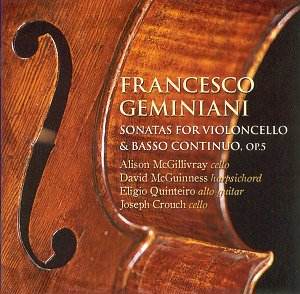|
|
Search MusicWeb Here |
|
 |
||
|
Founder:
Len Mullenger (1942-2025) Editor
in Chief:John Quinn
|
|
|
Search MusicWeb Here |
|
 |
||
|
Founder:
Len Mullenger (1942-2025) Editor
in Chief:John Quinn
|

BUY NOW AmazonUK AmazonUS
|
Francesco
GEMINIANI (1687-1762) Sonatas for Cello and Bass Continuo Op.5; Pièces de Clavecin Sonata in A Op.5 No 1 [11:31] Sonata in D minor Op.5 No 2 [11:02] Prelude (Lentement) and Vivement in D after Op.4 No 1 from Pièces de Clavecin (1743) [6:15] Sonata in C Op.5 No 3 [12:12] Tendrement in G minor after Op.1 No 6 from Pièces de Clavecin [3:34] Sonata in B flat Op.5 No 4 [5:39] Vivement in D after Op.4 No 4 from Pièces de Clavecin [3:50] Sonata in F Op.5 No 5 [7:15] Sonata in B flat after Op.5 No 4 from The Second Collection of Pieces for Harpsichord (1762) [4:48] Sonata in A minor Op.5 No 6 [8:49] Alison McGillivary (cello), David McGuinness (harpsichord), Eligio Quinteiro (alto guitar), Joseph Crouch (cello) Rec. St. Martin’s Church, East Woodhay, UK in August 2004 DDD/DSD Hybrid SACD playable on all CD players |
Error processing SSI file |
|
|
Return to Index |